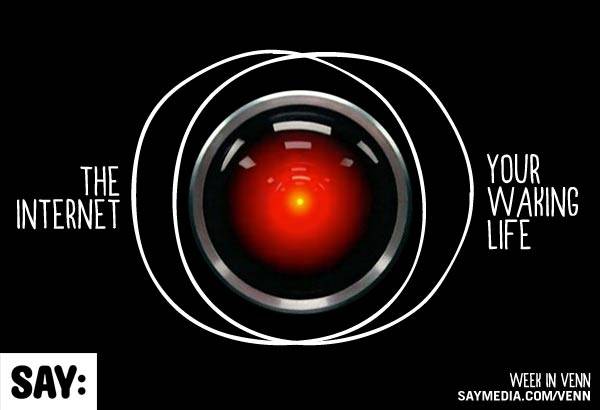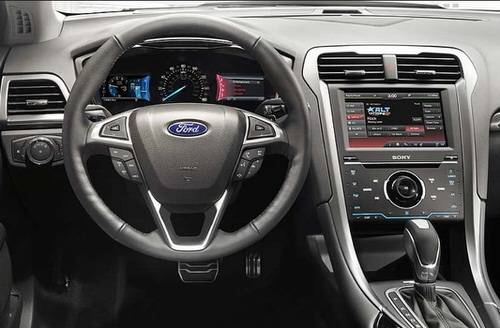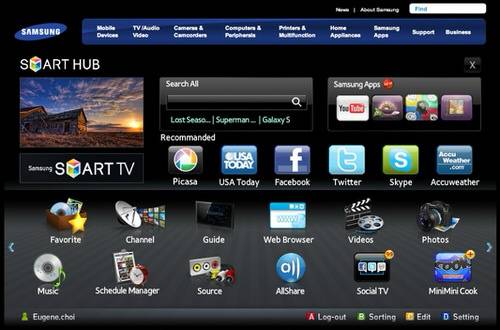
“This mission is too important for me to allow you to jeopardize it.” HAL; 2001: A Space Odyssey

Editor’s note: this is a longer version of ReadWriteWeb Editor-in-chief Richard MacManus’ article for the SAY Media newsletter. The newsletter is delivered weekly and features SAY Media’s take on media, culture, venn diagrams and the occasional Kubrick homage. You can sign up for it here.
Over half of all devices at this year’s CES, the world’s largest consumer electronics trade show, were Internet connected. Nearly 60% of those were non-traditional computing devices such as TVs, cars, refrigerators and washing machines. Connected devices are proliferating throughout our homes and the world around us. Which means consumers are about to become a whole lot more connected to the world.
According to the GSMA, a worldwide association of mobile operators and related companies, there are 9 billion connected devices in the world today. By 2020, there will be 24 billion and over half of them will be non-mobile devices such as household appliances. The GSMA estimates that connected devices will be a US$1.2 trillion market by 2020. So marketers and publishers better get ready for this new world too.
Reaching Consumers in Their Connected Cars
Consumers now expect to have a personalized media experience wherever they go. Look at how online music services have ramped up over the past year, in particular Pandora, Spotify, Rdio and MOG. With these services consumers can personalize their music listening on their computers, smartphones, tablets – and now their cars. The implication is that you’ll need to reassess how people discover and keep informed about your product or service. People will listen to the car radio less now, for example, because they can access a personalized music stream in their car via services like Spotify and Rdio.
Connected devices will be a US$1.2 trillion market by 2020. So marketers and publishers better get ready for this new world too.
At this year’s CES, car manufacturers such as Mercedes-Benz, Ford and Audi were touting new media and communications features. Commonly referred to as a connected car, the prevailing trend is to integrate smartphone apps into the car’s dashboard. This enables drivers and passengers to listen to online music, access news and other content, stream video and more.
The bad news for marketers is that this narrows the range of broadcast media where you can reach consumers even more. The car radio will soon be usurped by online content, whether it be for music or news. The good news is that because media is so much more personalized now, you will be able to target your message more precisely to the audience you want to reach. That’s because streaming media inside cars and throughout the home dramatically increases the amount of interest data collected about users. For example every song listened to on Spotify, no matter if it’s played on a computer or inside a car, is logged by Spotify (and increasingly Facebook) into a database with the rest of that user’s music preferences. It will all be anonymized, because privacy will become the biggest hot topic for users in this new era, but it’ll still be very valuable demographic and interest data for marketers.
Because media is so much more personalized now, you will be able to target your message more precisely to the audience you want to reach.
To give you an indication of how pervasive the trend of connected cars is becoming, look at the evolution of Ford.

The American firm first introduced Internet technology inside its cars with Sync, launched in 2007. Sync is voice-activated technology which connects your smartphone and MP3 player to your car’s dashboard and steering wheel. There are currently 4 million Ford cars in North America that have Sync running. The latest evolution of Sync is called MyFord Touch, an in-car communications and entertainment system which makes it even easier for drivers to consume Internet content.
In short, the connected car is going mainstream. In Ford’s newest hybrid car, the 2013 Fusion, one of the main features is its connection to the Internet.
Connected cars are set to ramp up rapidly in the coming years. The GSMA predicts that the automotive sector will account for 1.4 billion (nearly 6%) of the world’s 24 billion connected devices by 2020. If you’re a marketer or publisher, that’s a platform you’ll want to be on!
Internet TVs & Personalized Media
For the consumer, it’s all about personalizing one’s media experience. The TV is another device where this trend is playing out.
Traditional TV networks have already been disrupted by time-shifting devices, which enable consumers to fast forward through ads. The next step is bypassing TV networks altogether, as consumers increasingly access TV content via the Web. YouTube is undergoing a transformation as we speak: from a place to watch cat videos on a PC, to a place to watch high quality professional video content on a TV set.
Formats will evolve. We’ll see TV stars and brands creating their own YouTube channels and releasing short bursts of content to the Web.
While popular TV network shows such as Mad Men and Breaking Bad will continue to reach a large swath of people, Internet TV opens up opportunities for new types of video content to emerge and become popular too. Formats will evolve. We’ll see TV stars and brands creating their own YouTube channels and releasing short bursts of content to the Web. But also, we’ll see web applications arise that mix TV content with Internet programming. This is fertile ground for publishers to innovate and for marketers to latch onto to reach niche audiences.
The rise of Internet TV was evidenced at this year’s CES by Samsung’s announcements.

Samsung is the world’s No. 1 TV brand and it launched significant upgrades to its Smart TV product line. Samsung’s 2012 model TVs will enable users to consume a mix of traditional TV programming and Web apps. The devices are ready, now it’s time for new types of content and apps to bloom.
Another trend to watch is the increasing interactivity of TV. A key part of Internet TVs is moving beyond the remote control and into other forms of user interface. With a new feature that Samsung calls “Smart Interaction,” viewers will be able to control their TV using gesture and voice controls, as well as face recognition. This is similar to how Microsoft’s Kinect works on XBox. It will be an increasingly common form of user interface, as 24 billion devices go online over the next 8 years. Publishers and marketers will need to adapt to these new forms of interaction.
The next big thing in computing isn’t a new model smartphone or laptop. It’s the Internet empowering everything else around us.
The next big thing in computing isn’t a new model smartphone or laptop. It’s the Internet empowering everything else around us. Our cars, TVs and many other devices. Which means we all need to think about engaging digital Internet experiences for the car, TV and every device imaginable – because that’s where audiences are heading.










